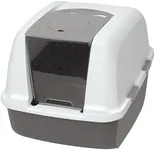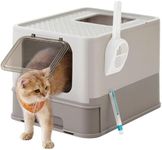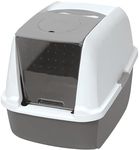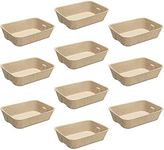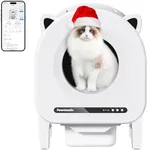Buying Guide for the Best Covered Litter Boxes
Choosing the right covered litter box for your cat is essential for maintaining a clean and odor-free home while ensuring your cat's comfort and privacy. When selecting a covered litter box, consider factors such as size, entry type, material, and additional features to find the best fit for your feline friend. Here are some key specifications to help guide your decision:SizeThe size of the litter box is crucial because it needs to be large enough for your cat to move around comfortably. A box that is too small can make your cat feel cramped and may lead to litter box avoidance. Generally, larger cats or multiple cats will require bigger boxes. Measure your cat and ensure the box is at least 1.5 times the length of your cat from nose to tail.
Entry TypeCovered litter boxes can have different entry types, such as front entry, top entry, or side entry. Front entry boxes are the most common and easiest for cats to access. Top entry boxes can help reduce litter tracking and are ideal for cats that are agile and enjoy climbing. Side entry boxes can be beneficial for older cats or cats with mobility issues. Consider your cat's age, agility, and preferences when choosing the entry type.
MaterialLitter boxes are typically made from plastic, which is durable and easy to clean. Some boxes may have additional features like antimicrobial coatings to help control odors and bacteria. Ensure the material is sturdy and easy to maintain. If you prefer eco-friendly options, look for boxes made from recycled materials.
Odor ControlOdor control is an important aspect of a covered litter box. Some boxes come with built-in filters or ventilation systems to help reduce smells. Consider boxes with replaceable carbon filters or those designed to minimize odor leakage. If odor control is a top priority, look for boxes with advanced odor management features.
Ease of CleaningA litter box that is easy to clean will save you time and effort. Look for boxes with removable lids, smooth surfaces, and minimal crevices where litter can get trapped. Some boxes have built-in mechanisms for easy scooping or self-cleaning features. Consider how often you are willing to clean the box and choose one that aligns with your maintenance preferences.
PrivacyCats often prefer privacy when using their litter box. A covered box can provide a sense of security and reduce stress for your cat. Ensure the box has enough coverage to offer privacy without making your cat feel trapped. Observe your cat's behavior to determine if they prefer more or less privacy.
Design and AestheticsThe design and aesthetics of the litter box can be important if you want it to blend in with your home decor. Covered litter boxes come in various shapes, colors, and styles. Choose a design that complements your living space while still meeting your cat's needs. Remember that functionality should always take precedence over appearance.
